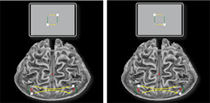Two brain halves, one perception
02 Sep 2011
In their study, Erhan Genç and colleagues used a motion illusion, called the ''motion quartet'', which can be perceived in two different ways. The ''motion quartet'' induces the phenomenon of apparent motion, where the impression of motion is caused by a sequence of static stimuli.
 This is similar to movies in TV or cinema, which consist of a sequence of still pictures that nevertheless generate a perception of natural dynamics. In the experiments, the stimuli are made up of four white squares in a rectangular arrangement. There are only two alternating movie frames with two pairs of diagonally opposing squares (upper left plus lower right vs. upper right plus lower left). In this case, observers see either horizontal or vertical motion; sometimes their perception switches between the two interpretations, although the stimulus remains unchanged.
This is similar to movies in TV or cinema, which consist of a sequence of still pictures that nevertheless generate a perception of natural dynamics. In the experiments, the stimuli are made up of four white squares in a rectangular arrangement. There are only two alternating movie frames with two pairs of diagonally opposing squares (upper left plus lower right vs. upper right plus lower left). In this case, observers see either horizontal or vertical motion; sometimes their perception switches between the two interpretations, although the stimulus remains unchanged.
Interestingly, it has been found that individuals predominantly perceive vertical motion when the distance between the four squares is equal and observers fixate at the centre of the quartet. Due to the organization of the visual system, visual information has to be integrated across the two hemispheres for horizontal apparent motion, whereas vertical apparent motion is processed only within the respective contralateral hemispheres. This explains the prevalence of vertical motion perception because the transfer across hemispheres takes longer than intra-hemispheric communication.
However, ''there are large inter-individual differences in this prevalence'', adds Erhan Genç, who conducted the study in collaboration with Johanna Bergmann, Wolf Singer and Axel Kohler. ''Our goal was therefore to examine whether these perceptual differences are due to differences in microstructural properties of the corpus callosum, the fibre system that connects the two cerebral hemispheres''.
For this purpose, the researchers determined the individual parity ratio for each of their participants. This measure reflects the equilibrium point for the motion quartet, where people perceive both motion directions equally often. In most participants, the parity ratio is below 1, as the horizontal distance needs to be smaller than the vertical to result in even visibility of horizontal and vertical motion.
Retests proved that the estimated values were reproducible over a time period of 16 weeks, demonstrating that the parity ratio is a stable characteristic of the observers' ability to integrate information across the two hemispheres. In addition, diffusion tensor imaging (DTI) was used to measure the features of fibre tracts in the corpus callosum. DTI was performed in the magnetic-resonance-imaging scanner of the Brain Imaging Center Frankfurt. The scanner uses the diffusion of water molecules as an indicator of fibre-tract integrity.
Analyses revealed that the properties of specific fibre tracts connecting regions specialized for visual motion processing could predict observers' individual parity ratio. ''It seems that participants with a faster nerve-conduction velocity mediated through larger diameters of nerve fibres are better at integrating visual information across both hemispheres'', explains Axel Kohler. Importantly, this relationship was restricted to visual motion centres. Neighbouring fibre tracts in the visual system connecting areas specialised for other stimulus features were not associated with the parity ratio.
''It is fascinating to see how closely inter-individual differences in conscious perception are linked to differences in the architecture of the brain'' comments Erhan Genç. The experiments establish how considerably anatomical differences in the layout of connections influence even very basic sensory processes, especially when communication across the brain hemispheres is required. Future research will investigate whether similar effects can be found for other visual features or sensory modalities, and whether other connections between the hemispheres outside the corpus callosum also determine our individual subjective experience.













.jpg)






.jpg)









